AI agents have evolved from conceptual innovations into essential enablers of efficiency, insight, and strategic growth for enterprises. Yet realizing their full potential is rarely straightforward.
Consider your teams: which processes consume the most time, create bottlenecks, or hinder operational performance? The defining question for leaders is clear: which processes should your AI agent tackle first? The answer determines whether a pilot becomes a scalable, high-impact system or stalls, leaving time, resources, and opportunities unrealized.
Every enterprise faces this pivotal juncture. Initial excitement can quickly give way to stalled initiatives if priorities are unclear: workflows remain fragmented, insights emerge too slowly, and teams face frustration. Selecting the right starting process transforms uncertainty into momentum. Repetitive tasks are streamlined, actionable insights emerge in real-time, and teams focus on high-value initiatives that drive innovation, operational excellence, and a competitive advantage.
Beyond operational efficiency, strategic implementation uncovers hidden opportunities, generates deeper insights, and aligns AI agents with enterprise objectives, turning technology into a trusted partner for transformation. True success lies not just in deploying an AI agent, but in crafting an approach tailored to your organization’s priorities, technology, and workflows, ensuring each step delivers measurable impact.
This guide provides a structured, step-by-step roadmap to implement your first AI agent with confidence, helping you determine the approach that best fits your business, select the right tools and technologies, and address critical considerations, giving a clear, actionable path to success and a foundation for lasting impact.
Approaches to building AI agents
Enterprises can take three main paths to build AI agents, balancing control, speed, and potential business impact. Selecting the right approach depends on your organization’s resources, technical expertise, timelines, and strategic priorities. Understanding the strengths, limitations, and practical implications of each path ensures that your first AI agent delivers tangible results while aligning with enterprise workflows and operational goals.
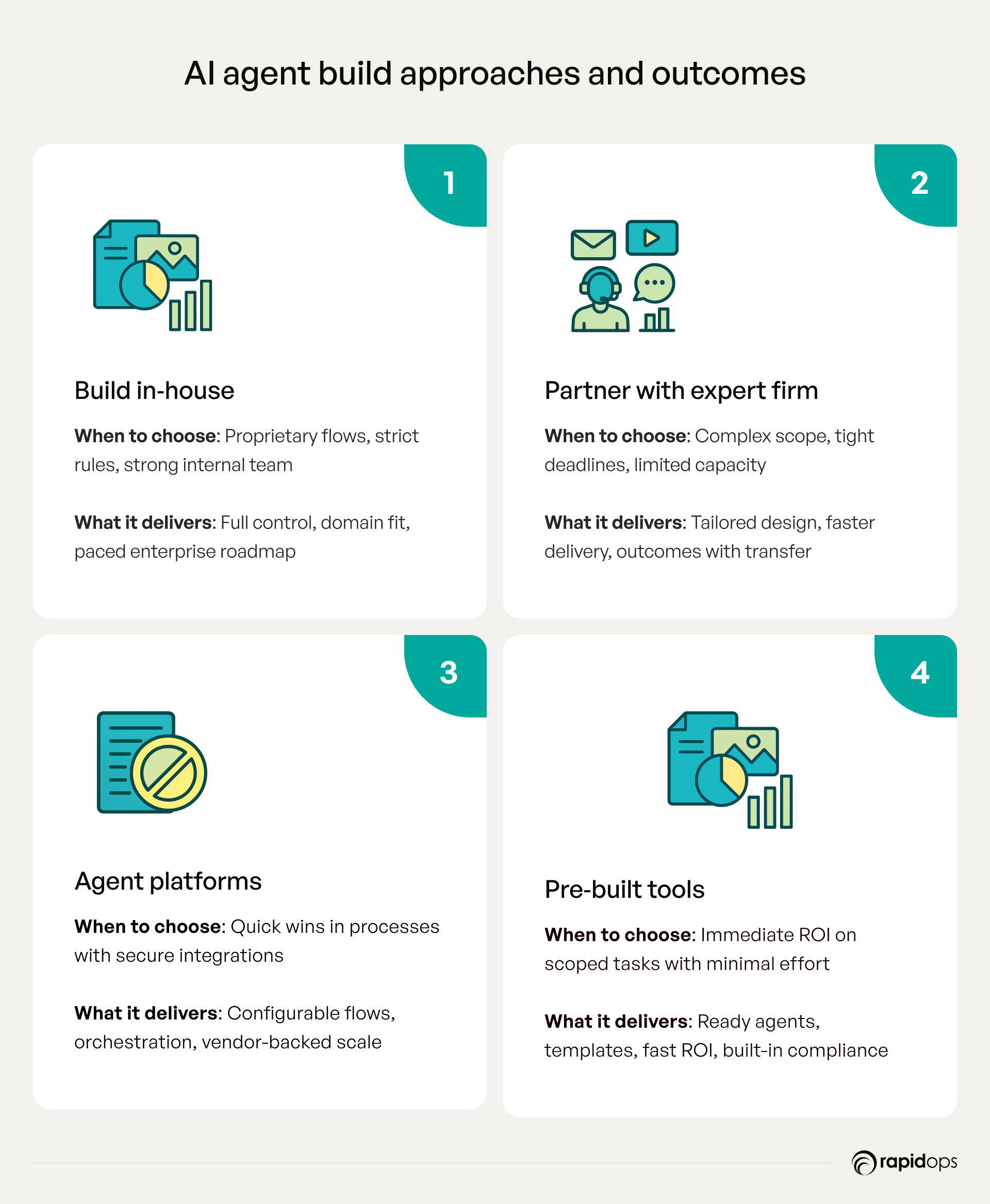
1. Build in-house (Custom development)
For enterprises pursuing large-scale, high-impact initiatives, building an AI agent in-house offers unmatched control over every aspect of the system. This approach is ideal for organizations with proprietary workflows, sensitive intellectual property, or unique operational processes that require complete customization.
By building your AI agents from the ground up, you gain the ability to define reasoning loops, decision-making logic, and user interactions exactly to your enterprise standards, creating a solution that can become a strategic differentiator.
Unlike off-the-shelf solutions, in-house development allows you to design AI agents tailored to specific workflows and business processes, ensuring seamless integration into existing systems.
Enterprises can optimize data pipelines, align AI tasks with team responsibilities, and embed domain-specific knowledge directly into the agent’s architecture, making it a true extension of your operational capabilities.
Key points
- Requires building everything from scratch, including reasoning logic, data integration, UI/UX, and feedback loops.
- Necessitates multiple dedicated teams spanning data scientists, MLOps engineers, software developers, and domain experts to manage design, development, and ongoing maintenance.
- Frameworks such as LangChain, CrewAI, and AutoGen can help structure development while retaining complete custom control.
- Allows full control over agentic capabilities, workflow automation, and task orchestration, ensuring the AI agent works exactly as needed within enterprise systems.
- Supports continuous evolution of the agent based on enterprise-specific insights and feedback, enabling sustained improvement over time.
Trade-offs
- Significant investment in both time and financial resources, with longer time-to-value compared to pre-built platforms.
- Requires highly specialized talent for ongoing development, testing, and maintenance.
- Only practical for enterprises capable of supporting long-term development and operational oversight.
The in-house approach is ideal for enterprises seeking full control, strategic differentiation, and long-term competitive advantage, especially those with sufficient resources to invest without budget constraints.
Though resource-intensive, it enables organizations to develop AI agents that are precisely aligned with proprietary workflows, seamlessly integrated into enterprise systems, and capable of delivering sustained operational efficiency, innovation, and measurable business impact.
2. Agent platforms
For enterprises seeking rapid deployment and lower operational risk, Agent Platforms offer pre-built, enterprise-ready solutions to implement AI agents efficiently. This approach is ideal for organizations looking to achieve measurable impact quickly, without building agents from scratch, while maintaining the flexibility to align AI capabilities with strategic priorities.
By leveraging these platforms, enterprises can focus on solving business challenges rather than managing low-level architecture, infrastructure, or integration complexities. Unlike fully custom solutions, agent platforms come with configurable frameworks, pre-built workflows, and system integrations that allow AI agents to be operational faster and at scale.
Teams can connect AI agents to existing enterprise systems, configure tasks according to priorities, and leverage built-in best practices for security, compliance, and scalability, ensuring the AI agent becomes a reliable and strategic partner in daily operations.
Key points
- Rapid, plug-and-play implementation to achieve business outcomes quickly.
- Scalable architecture suitable for enterprise-wide deployment.
- Pre-built integrations allow seamless connectivity with existing systems and workflows.
- Reduces dependency on specialized AI engineering talent.
- Configurable workflows and tasks provide flexibility to align with business priorities.
Trade-offs
- Limited control over low-level architecture and detailed agent design.
- Customization may be constrained by platform capabilities.
- May not fully accommodate highly specialized or unique operational scenarios.
Agent Platforms are best suited for enterprises that prioritize speed, reliability, and scalability over complete customization. They enable organizations to implement AI agents efficiently, unlock measurable value quickly, and reduce development complexity, while maintaining flexibility to align AI agents with strategic business objectives and operational workflows.
3. Partnership with expert AI development company
When internal AI expertise is limited, enterprises don’t have to compromise on ambition. Partnering with an expert AI development company provides a strategic path to deploy enterprise-grade AI agents efficiently while leveraging specialized knowledge, frameworks, and best practices that may not exist in-house.
This approach bridges the gap between vision and execution, enabling organizations to harness AI capabilities rapidly, with solutions fully customizable to their specific requirements and operational needs.
Why choose this approach
- Ideal for enterprises seeking high-quality, scalable AI agents without the need to recruit, train, and maintain specialized AI talent internally.
- Leverages external expertise to accelerate delivery, maintain quality standards, and reduce development risk across enterprise workflows and systems.
- Provides strategic guidance, ensuring AI agents are aligned with business objectives, compliance requirements, and long-term operational goals.
Key points
- Expert partners handle the full lifecycle of AI agent development, including architecture design, system integration, testing, scaling, and ongoing maintenance.
- Access to advanced tools, frameworks, and methodologies accelerates building AI agents, enabling faster time-to-value.
- Supports deployment in critical enterprise processes such as predictive analytics, automated customer support, workflow optimization, and other use cases where precision and reliability are essential.
- Partners provide insights on data integration, feedback loops, and agentic capabilities, ensuring AI agents evolve effectively over time.
- Fully customizable solutions that cater directly to your specific requirements while enabling rapid development.
Trade-offs
- Offers less internal control over development compared to in-house or framework-based approaches, requiring trust and alignment with the partner.
- Requires careful partner selection to ensure technical capability, cultural fit, and strategic alignment with enterprise objectives.
- Can be slightly more costly than pre-built software solutions, though the incremental investment is offset by tailored capabilities, faster delivery, and reduced operational overhead.
Working with an expert AI development company allows enterprises to implement AI agents quickly and effectively, leveraging specialized expertise to deliver impact while minimizing internal resource demands.
4. Buy pre-built tools
When speed and simplicity are the top priorities, enterprises can turn to pre-built AI tools. These tools provide ready-to-use AI agents, enabling organizations to deploy capabilities quickly with minimal technical overhead, built-in enterprise compliance, and measurable ROI from day one. This approach is ideal for teams seeking rapid impact without the complexity of building or customizing an agent in-house.
Why choose this approach
- Perfect for organizations that need immediate results and low operational risk.
- Provides out-of-the-box enterprise-grade features such as security, compliance, and scalable workflows.
- Allows teams to focus on strategic outcomes rather than development, integration, or ongoing maintenance.
Key points
- Popular platforms include Moveworks, Vertex AI, Jotform AI Agents, and Operator, offering no-code or low-code setups for fast deployment.
- Rapidly integrates into existing workflows and systems, enabling quick realization of measurable ROI.
- Suitable for operational use cases such as automated support, workflow optimization, and efficiency improvements.
- Offers pre-configured tools, frameworks, and templates that reduce technical effort while maintaining reliability.
Trade-offs
- Limited customization compared to in-house or framework-based development.
- Best suited for tactical initiatives or projects prioritizing speed and immediate ROI over full differentiation.
- May not cover highly specialized or proprietary workflows without additional adaptation.
Pre-built AI tools provide a fast, low-risk route to deploy enterprise-ready AI agents. They deliver immediate operational value, reduce technical complexity, and allow teams to focus on business outcomes, while giving enterprises the flexibility to scale and adapt tools as needed.
Critical tools and technologies executives need for enterprise AI agents
Building AI agents goes far beyond selecting algorithms, it requires a comprehensive ecosystem of models, data pipelines, deployment channels, and monitoring tools. For enterprises, choosing the right tools determines whether an AI initiative scales successfully or remains a proof-of-concept that fails to deliver measurable business impact. Executives must understand not only the technical capabilities but also the strategic role these technologies play in driving efficiency, personalization, and decision-making.
Core AI models and frameworks
At the heart of every AI agent are the models that power reasoning, decision-making, and personalized interactions. Enterprises can leverage GPT-4, fine-tuned large language models (LLMs), and domain-specific models to ensure accuracy, adaptability, and relevance to their industry context. Selecting the right frameworks and models enables AI agents to execute complex tasks, understand nuanced enterprise data, and provide actionable insights that drive strategic outcomes.
Data sources and integration tools
A high-performing AI agent relies on seamless access to enterprise data. Integrating CRM, ERP, product catalogs, IoT devices, and knowledge bases ensures that AI agents have the context needed to make informed decisions.
Prioritizing data quality, governance, and security is essential, as is ensuring smooth connectivity across workflows and systems. Strong integration allows AI agents to generate real-time insights, optimize operational processes, and provide consistent, reliable outputs for both employees and customers.
Interaction and deployment channels
To maximize impact, AI agents must be accessible across the channels that matter most. Messaging apps, web chat, in-app chat, and voice assistants create omnichannel experiences, enabling consistent interactions for both customer-facing and employee-facing use cases. Flexible deployment ensures that AI agents support enterprise goals across multiple touchpoints, improving engagement, reducing friction, and enhancing the overall experience.
Monitoring, analytics, and feedback tools
Continuous improvement is critical for enterprise AI agents. KPI dashboards, performance tracking, and analytics tools provide visibility into key metrics such as response time, operational efficiency, conversion rates, and accuracy. By implementing closed-loop feedback mechanisms, organizations can refine reasoning, optimize workflows, and ensure that AI agents continue to evolve in alignment with enterprise objectives. Monitoring also supports risk mitigation, compliance, and strategic decision-making at the executive level.
For decision-makers, understanding the critical tools and technologies behind AI agents is as important as defining the approach. By combining the right models, robust data pipelines, integrated deployment channels, and monitoring tools, enterprises can build AI agents that deliver measurable business impact, accelerate workflows, and enhance both employee and customer experiences.
Step-by-step process to build your first AI agent
The journey to implement an AI agent is as much about people and processes as technology. A structured approach enables organizations to harness AI’s potential, optimize workflows, enhance operational intelligence, and create a system that continuously adapts, learns, and generates value across every part of the enterprise.
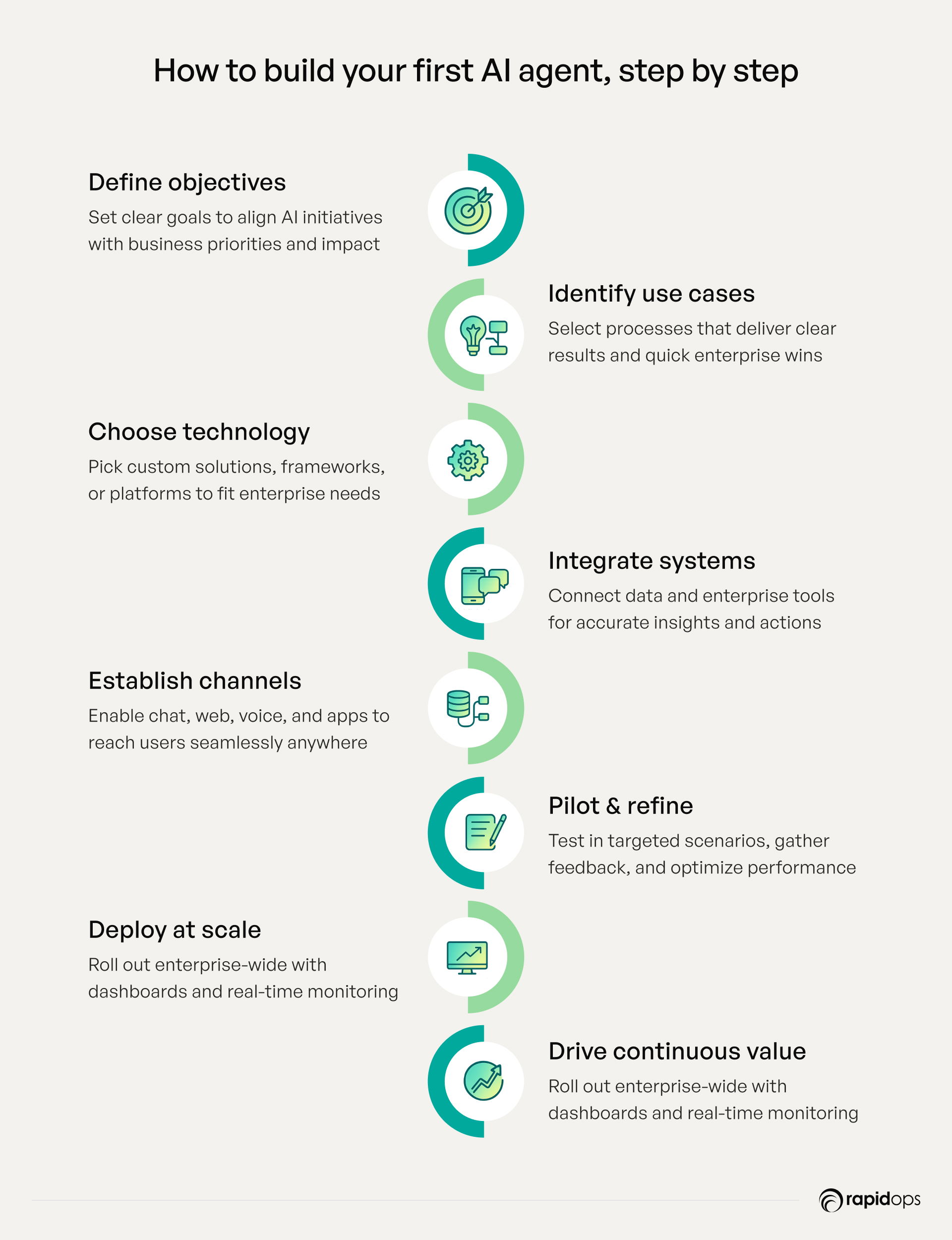
Step 1: Define objectives and scope
The first step in building your AI agent is to clearly define the purpose, objectives, and scope of the initiative. This stage is not just about setting goals, it is about creating a strategic blueprint that ensures the AI agent delivers tangible value, aligns with enterprise priorities, and addresses the challenges that matter most. Without this clarity, even the most sophisticated AI tools risk becoming underutilized or misaligned with organizational needs.
Begin by identifying the core business challenge or opportunity driving the initiative. Whether it’s automating repetitive tasks, enhancing customer experiences, accelerating operational efficiency, or unlocking actionable insights from complex data, framing the AI agent around a real enterprise need ensures measurable impact.
Equally important is defining the scope of the agent. Decide whether it will focus on a single process or workflow, such as customer support ticketing or internal approvals, or whether it will operate across multiple systems and departments for enterprise-wide deployment. A well-defined scope informs resource allocation, clarifies integration requirements, and helps manage risk, ensuring the initiative remains feasible and strategically relevant.
Next, set strategic objectives that align with organizational priorities. These objectives could include improving operational efficiency, boosting revenue, enhancing customer satisfaction, or fostering innovation. Clear, measurable goals allow executives to track performance, justify investments, and ensure the AI agent contributes meaningfully to enterprise outcomes.
Finally, ensure objectives and scope align with the enterprise vision. With executive buy-in and cross-functional collaboration, the AI agent becomes a strategic enabler, transforming workflows, empowering teams, and delivering sustainable business impact.
Step 2: Select the right use cases
Once objectives and scope are clearly defined, the next step is identifying the right use cases for your AI agent. Not all processes are equally suited for automation, so it’s critical to select opportunities that combine high impact with quick implementability, low-hanging fruit that can demonstrate the power of AI agents early and build momentum for broader adoption.
Examples include customer support automation, personalized product recommendations, predictive inventory management, and fraud detection, areas where AI delivers immediate operational efficiency and measurable strategic value.
Prioritization should consider ROI potential, operational necessity, scalability, and ease of integration with existing workflows. Focusing on use cases that generate tangible value quickly ensures early wins, builds stakeholder confidence, and provides actionable insights to guide subsequent AI initiatives.
Avoid overextension. Beginning with one or two carefully chosen use cases allows your team to refine processes, validate AI performance, and establish a scalable framework for enterprise-wide deployment.
By selecting use cases strategically balancing impact, feasibility, and speed of implementation, organizations can maximize results, minimize risk, and create a strong foundation for long-term AI adoption and transformation.
100 proven AI agent use cases delivering immediate impact, without the need for massive technology overhauls!
Download Now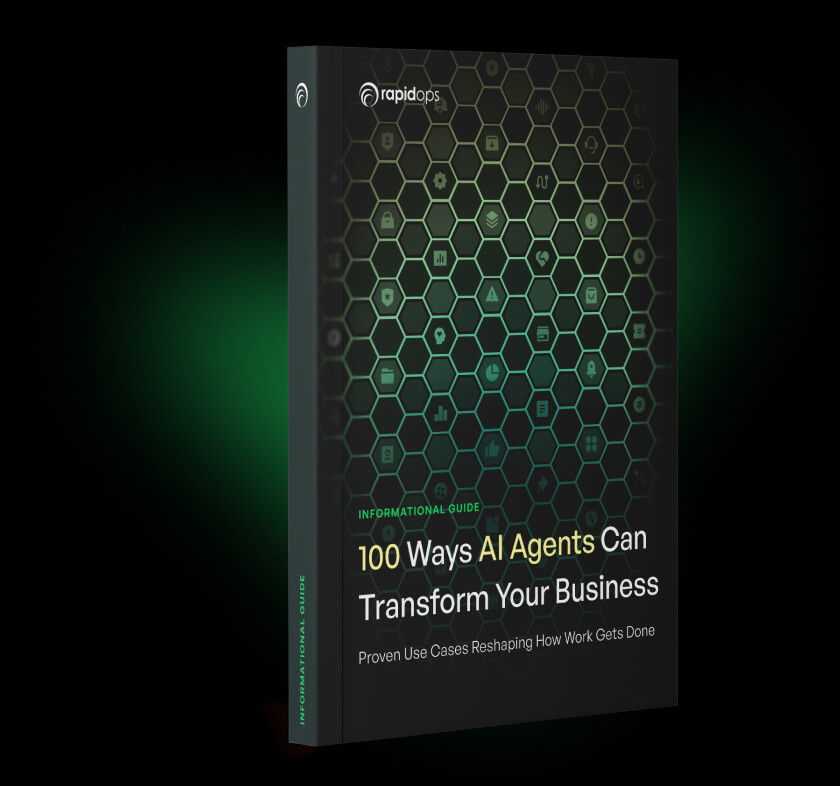
Step 3: Select approach and technology
With the right use cases identified, the next critical step is selecting the approach and technology that will bring your AI agent to life. This choice shapes deployment speed, control over AI logic, scalability, and overall business impact. Choosing wisely ensures the agent delivers measurable outcomes while aligning with enterprise priorities.
Enterprises typically evaluate three main approaches: custom development, agentic frameworks, and enterprise platforms.
Custom development offers full control, making it ideal for IP-sensitive initiatives or projects requiring highly differentiated AI agents. Organizations can design reasoning logic, workflows, and integrations from scratch, ensuring the solution is fully tailored to proprietary processes.
While this approach enables maximum flexibility and strategic advantage, it requires higher investment, longer timelines, and specialized talent for ongoing maintenance.
Agentic frameworks, such as LangChain or AutoGen, provide a balance between speed and customization. These frameworks include prebuilt reasoning loops, integrations, and structured workflows while allowing moderate tailoring.
They accelerate development, reduce operational complexity, and are well-suited for enterprises seeking rapid deployment without sacrificing strategic differentiation.
Enterprise platforms, including Moveworks and Vertex AI, deliver the fastest time-to-value. These solutions are enterprise-ready, offering built-in compliance, security, and low operational overhead.
Customization is more limited compared to frameworks or full custom development, but platforms are ideal for tactical initiatives or deployments focused on immediate ROI.
If internal resources or expertise are limited, selecting the right partner can simplify this process. A capable partner can manage the full tech stack, integrations, and deployment, ensuring the AI agent is production-ready without requiring your teams to handle every technical detail.
By carefully selecting the right approach and technology or the right partner, you position your AI agent for successful implementation, seamless workflow integration, scalable deployment, and measurable, sustainable business impact.
Step 4: Integrate data and systems
The next critical step is to integrate the AI agent with key enterprise systems and data sources. Seamless integration ensures the agent has access to accurate, real-time information, enabling it to automate enterprise workflows, generate insights, and deliver measurable business impact across the organization.
Begin by connecting core enterprise systems such as ERP, CRM, supply chain management, IoT networks, and product catalogs. This unified access allows the AI agent to understand complex business processes, make informed recommendations, and act intelligently across departments.
Maintaining data quality, governance, and compliance at every stage is essential. Reliable data forms the backbone of effective AI performance. Establish robust practices for data validation, access control, and adherence to regulatory standards to mitigate risk while maintaining operational efficiency.
Finally, enable APIs and middleware to orchestrate data flows smoothly between systems and the AI agent. Well-structured interfaces and automated pipelines ensure the agent operates on the most current information, supports real-time decision-making, and scales efficiently as enterprise needs evolve.
By integrating systems thoughtfully, organizations empower their AI agents to function as a connected, intelligent layer across the enterprise, driving operational efficiency, strategic insight, and sustainable business value.
Step 5: Implement user interaction channels
Once the AI agent is integrated with core systems, the next priority is to establish user interaction channels. These channels serve as the bridge between the AI agent and its end users, whether employees or customers, and determine how effectively the agent delivers value and engages stakeholders.
Deploy messaging apps, web chat, in-app assistants, and voice interfaces to provide multiple avenues for interaction. This omnichannel approach ensures that users can access the AI agent wherever they work or engage with your business, creating a seamless and consistent experience across all touchpoints.
Equally important is maintaining accuracy, tone, and personalization. The AI agent should respond reliably, reflect your enterprise’s brand voice, and adapt to individual user needs. Personalization strengthens engagement, builds trust, and ensures that interactions feel intuitive and contextually relevant.
By thoughtfully implementing user interaction channels, organizations ensure the AI agent is not only operationally effective but also delivers meaningful, user-centric experiences that drive adoption, satisfaction, and measurable business outcomes.
Step 6: Test, refine, and pilot
Before scaling your AI agent enterprise-wide, it’s essential to test, refine, and pilot its capabilities in controlled, high-value scenarios. This step ensures the agent operates effectively, aligns with business priorities, and delivers measurable impact while minimizing operational risk.
Start by selecting limited-scope, low-risk processes that offer high potential value, such as targeted customer support tasks, inventory predictions, or internal workflow automations. Piloting in these areas allows organizations to observe performance in real-world conditions and demonstrate early wins that build confidence among stakeholders.
Track performance against key KPIs, including accuracy, response time, user satisfaction, and adoption rates. These metrics provide actionable insights into how well the AI agent meets operational needs and highlights areas for refinement.
Incorporate structured feedback loops from both users and operations teams. Iterative improvements based on real-world usage ensure the AI agent continuously adapts, enhances workflows, and better serves enterprise objectives.
By piloting thoughtfully, enterprises lay the groundwork for scalable deployment, ensuring the AI agent not only automates tasks but also drives strategic value, operational efficiency, and sustainable business outcomes.
Step 7: Deploy and monitor
With the AI agent successfully piloted and refined, the next step is to deploy it at scale across the enterprise while establishing continuous monitoring mechanisms. Scaling transforms the AI agent from a controlled experiment into a strategic, operational asset that drives measurable business outcomes across teams, processes, and customer touchpoints.
Provide real-time dashboards, alerts, and reporting tools for executive oversight. These enable leaders to track critical metrics such as efficiency gains, downtime reductions, user adoption, response accuracy, and workflow optimization.
By maintaining visibility into performance, executives can ensure alignment with strategic priorities, quickly identify deviations, and make informed decisions that maximize ROI.
Monitoring should not be static. Implement continuous feedback loops that capture insights from end users, operations teams, and system performance. Use these insights to refine reasoning, optimize workflows, and address emerging challenges proactively. This approach ensures the AI agent evolves with enterprise needs, maintaining high relevance and effectiveness over time.
Additionally, assess the long-term operational impact. Evaluate how the AI agent contributes to strategic initiatives, workforce enablement, customer satisfaction, and process innovation. Integrating deployment with active monitoring ensures the AI agent remains a scalable, adaptive, and high-value enterprise capability, capable of driving sustainable transformation while providing executives with confidence in both operational and strategic outcomes.
Step 8: Continuously improve
Even after full deployment, the work doesn’t stop. To ensure AI agents remain strategically relevant and operationally effective, organizations must embrace a mindset of continuous improvement. Regularly collect feedback from stakeholders, including employees, customers, and operational teams, to identify opportunities for enhancement, uncover pain points, and surface emerging needs.
Use this feedback to retrain and fine-tune AI models with enterprise data, ensuring the agent adapts to evolving workflows, new processes, and changing business priorities. Continuous learning strengthens accuracy, relevance, and the agent’s ability to drive measurable outcomes.
Expand the AI agent’s capabilities to adjacent use cases where automation, intelligence, or personalization can add incremental value. This iterative approach allows organizations to scale impact without starting from scratch, gradually transforming the AI agent into a versatile enterprise asset.
Finally, measure sustained impact on KPIs such as efficiency, adoption, customer satisfaction, and revenue growth. Use these insights to refine strategy, prioritize enhancements, and maintain a competitive edge in an increasingly data-driven business environment.
By embedding continuous improvement into the AI lifecycle, enterprises ensure that their AI agents remain dynamic, adaptive, and consistently aligned with strategic objectives.
Things to consider when implementing enterprise AI agents
Successfully implementing AI agents at an enterprise scale requires a deliberate strategy, careful planning, and seamless coordination across teams. Addressing key considerations ensures AI agents provide meaningful, measurable value while minimizing risks and maximizing adoption.
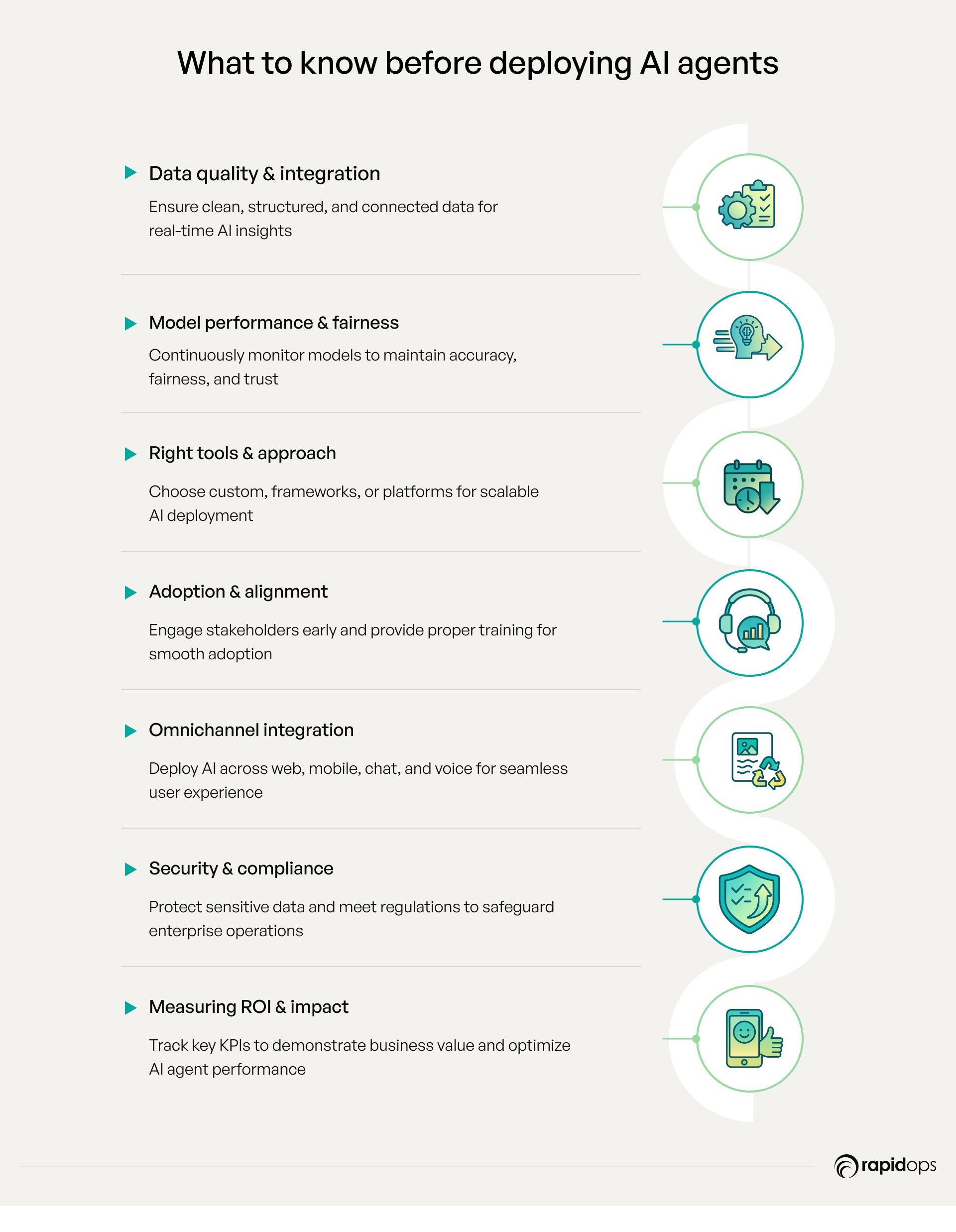
1. Data quality and integration
High-quality, reliable data forms the foundation of effective AI. Ensure your enterprise systems ERP, CRM, product catalogs, IoT, and other data sources are clean, structured, and fully integrated. This enables real-time insights and ensures your AI agents operate on accurate information across workflows.
2. Model performance, accuracy, and fairness
Continuously evaluate AI models to maintain high accuracy, prevent bias, and preserve trust in business-critical processes. Fine-tuning models based on feedback and evolving data ensures sustained performance and actionable outputs.
3. Choosing the right development approach and tools
Decide whether to leverage a custom-built solution, agentic framework, or enterprise platform based on your business objectives, available resources, and deployment timeline. Selecting the right approach and tools balances control, speed, scalability, and aligns AI agent capabilities with enterprise workflows.
4. Driving adoption and organizational alignment
Early stakeholder engagement and clear communication of purpose are critical. Provide guidance and training to embed AI agents into existing workflows, ensuring teams understand how the technology supports their tasks and decision-making processes.
5. Omnichannel and workflow integration
Deploy AI agents consistently across web, mobile, messaging, and voice interfaces to deliver seamless experiences. Integration into workflows allows AI agents to assist in multiple processes, from customer support to internal task automation, enhancing productivity and collaboration.
6. Enterprise-grade security, privacy, and compliance
Implement robust security measures and ensure compliance with regulatory standards at every stage. Protecting sensitive data while maintaining system integrity fosters confidence among stakeholders and safeguards operational continuity.
7. Measuring ROI and business impact
Define clear KPIs including efficiency, adoption, customer satisfaction, and revenue impact and track them consistently. Use these insights to refine AI strategies, optimize agent performance, and demonstrate tangible value across the enterprise.
By proactively addressing these factors, enterprises can maximize the strategic impact of AI agents, unlock deeper insights, streamline workflows, and create a foundation for sustained innovation, operational excellence, and competitive advantage.
Don't think of deploying AI agents without knowing these key factors that drive success & prevent costly mistakes
Download Now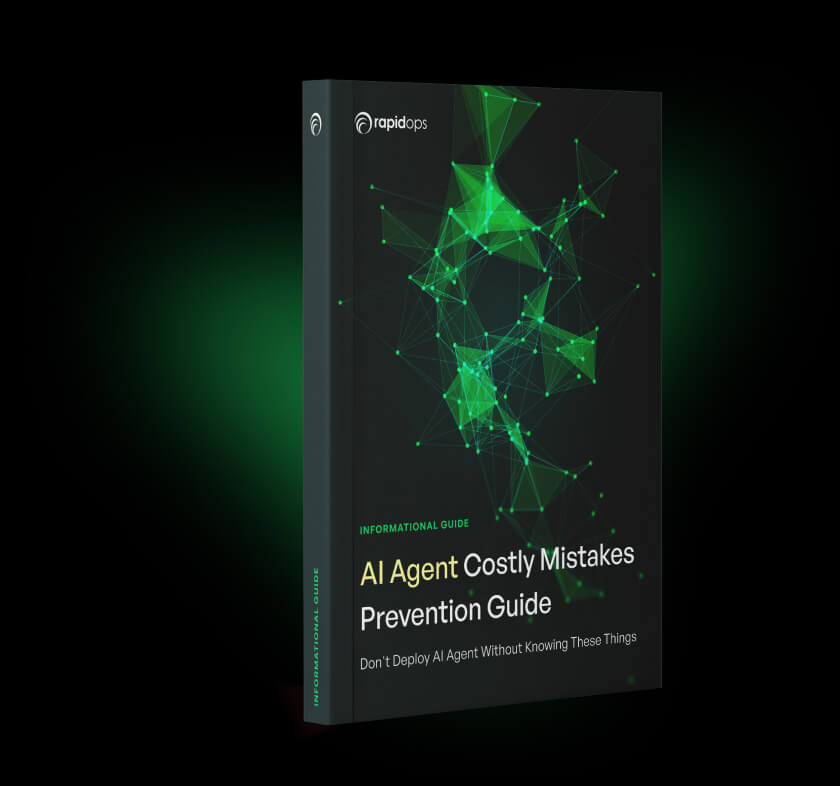
Building AI agents that deliver measurable enterprise value
For enterprises ready to harness AI agents, the key is building a solution that aligns with your business, technology, and workflows. When implemented thoughtfully, AI agents act as intelligent collaborators streamlining critical processes, enabling teams to focus on strategic initiatives, and creating measurable impact from day one.
Start with a high-value pilot: choose a meaningful use case, define clear objectives, and track outcomes carefully. Iterate and refine to ensure smooth integration with existing systems, adherence to governance standards, and alignment with your enterprise goals. This approach transforms a single AI agent into a scalable solution that grows with your organization.
At Rapidops, we partner with enterprises to guide every step, from identifying high-impact use cases to implementing and optimizing AI agents and agentic platforms. Our expertise ensures your pilot demonstrates tangible value and lays the foundation for broader enterprise adoption.
Next step: Schedule an appointment with one of our AI agent experts to shape your pilot and ensure your first AI agent delivers real, measurable results, becoming a trusted collaborator that drives lasting impact across your organization.

Rahul Chaudhary
Content Writer
With 5 years of experience in AI, software, and digital transformation, I’m passionate about making complex concepts easy to understand and apply. I create content that speaks to business leaders, offering practical, data-driven solutions that help you tackle real challenges and make informed decisions that drive growth.
What’s Inside
- Approaches to building AI agents
- Critical tools and technologies executives need for enterprise AI agents
- Step-by-step process to build your first AI agent
- Step 1: Define objectives and scope
- Step 2: Select the right use cases
- Step 3: Select approach and technology
- Step 4: Integrate data and systems
- Step 5: Implement user interaction channels
- Step 6: Test, refine, and pilot
- Step 7: Deploy and monitor
- Step 8: Continuously improve
- Things to consider when implementing enterprise AI agents
- Building AI agents that deliver measurable enterprise value

Let’s build the next big thing!
Share your ideas and vision with us to explore your digital opportunities
Similar Stories
- AI
- 4 Mins
- September 2022

- AI
- 9 Mins
- January 2023


Receive articles like this in your mailbox
Sign up to get weekly insights & inspiration in your inbox.

